

|
In my discussion of Complete System Backup I recommended using a stand-alone program that creates a complete backup of your C drive which can be easily restored to a newly formatted hard drive when your C drive fails or becomes hopelessly corrupted by a virus. You notice I said when, not if, because sooner or later it's going to happen to you. As promised I would a month ago, I just tested the Acronis Backup Product. For now I'm afraid I have to rate Acronis True Image Home unacceptable. I'll explain why below, but first I'll show you what I saw during my initial use of the product. Like the Paragon product, you don't start with a stand-alone version. That's fine; many backups can be done while Windows is running. Both Paragon and Acronis will do a complete backup of your primary hard-drive (the one where Windows is installed and running) while Windows is running ... elsewhere I've explained why I prefer to do this backup stand-alone. But let's see how this backup works under windows. Here I'm using version 10 of True Image (I asked Acronis twice to send me the latest version for evaluation, but they never did ... you can download a trial, but it's only good for 15 days ... I'm not sure what other limitations it has). After starting Acronis, the first thing I wanted to do was create a full backup of my primary drive, so I chose "Backup":
|
Sponsored Links:
|
This starts a "wizard" to guide you through the process, click on "Next":
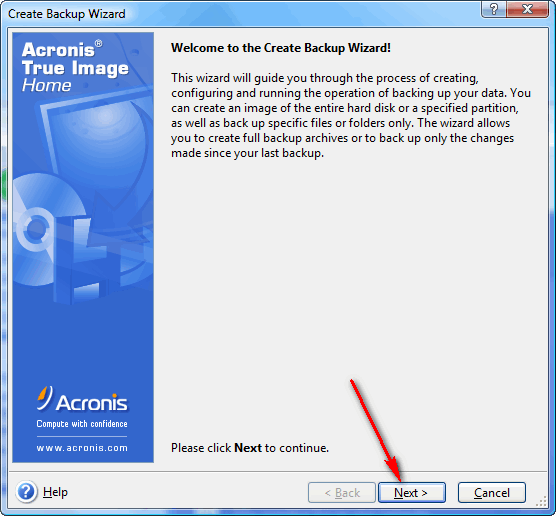
Since I wanted to backup my primary drive, I selected "My Computer" and clicked "Next":

I selected my primary drive and clicked "Next". Be careful, you'll note that the order the drives are listed in doesn't always correspond to the order they appear when listed in Windows. Here drive F comes between drive C and D. It's another reason why it's so important to change the volume labels of your drives so that you can uniquely identify them. (My internal drives are labeled with the computer name and drive letter on that computer, external drives are labeled with colors which match a the labels on the outside of the drive. Here the red drive is actually an internal drive which I treat as an external drive ... I take it out and leave it behind when I move my computer to protect me against fire, theft, etc.)
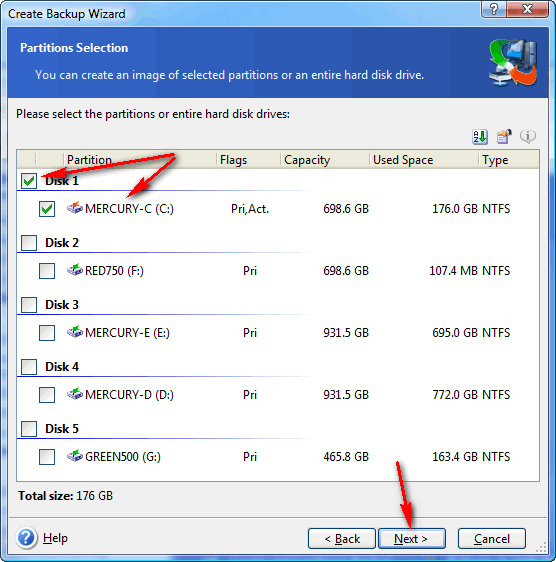
You then get this screen which reminds you of your various options and what to do in each case. One of the features I really like in Acronis is their differential backup. The concept is that you make a full backup (once a week, once a month, or whatever) and then in between you can make differential backups which include everything that's changed since the last full backup. All you need to keep is the full backup and the last differential backup; they're all you need to restore to get your machine back to where it was when you made the last differential backup.
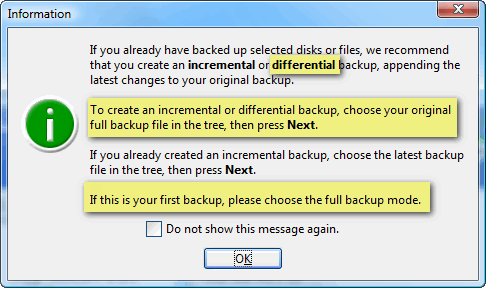
Since I'm making a full backup, I need to navigate to where I want it placed. Here I've selected a folder (named #Green500WD) on a 500GB external drive. Then I like to create a sub-folder for each backup, so I click on "Create new folder":
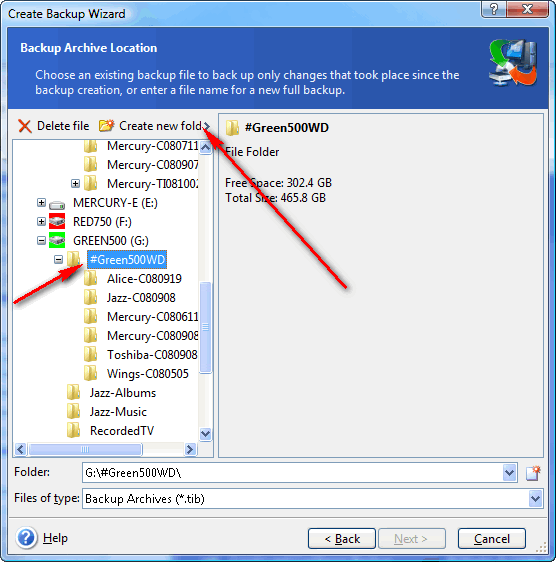
Here you see I've named the folder with the computer name, drive letter, date (and since this is a different backup program I added "ATI" to the end of the name to remind me it was done with Acronis True Image). You also need to type in the name you want to assign to the backup, or click on the button (arrow) which generates a name for the backup:
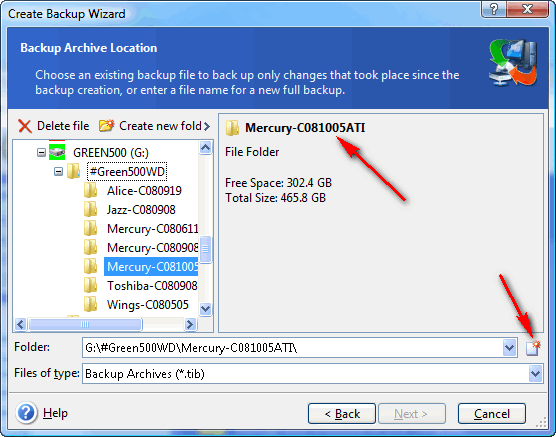
I'm not impressed by it's file naming. As you can see, the name it choose is pretty meaningless, but since we put it in a folder which makes sense to us, we'll go with it:
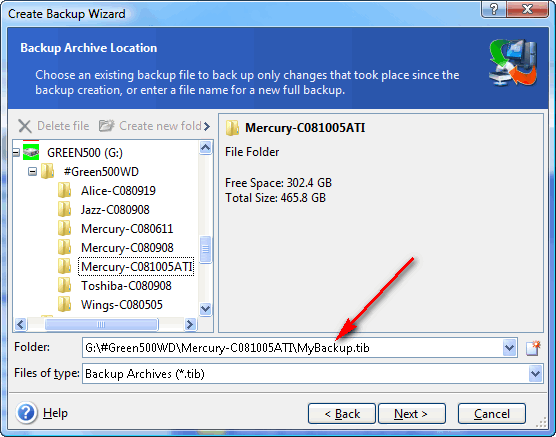
Choose the kind of backup and click "Next". Remember that if you want to create a differential backup, instead of creating a new folder and backup name (above) you would choose your previous full backup.
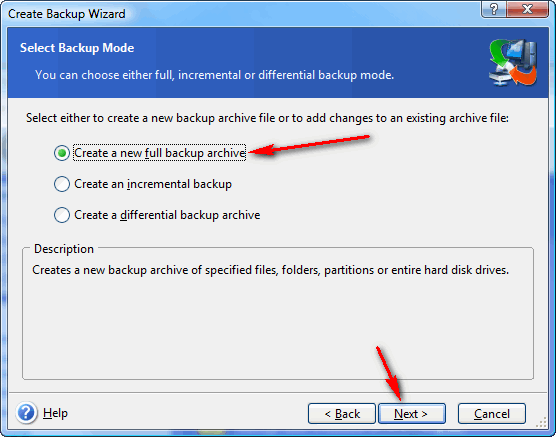
Here you want to review the backup options. (Sometime in the future, when you're familiar with all the options you can set the defaults the way you want them and use that choice.):
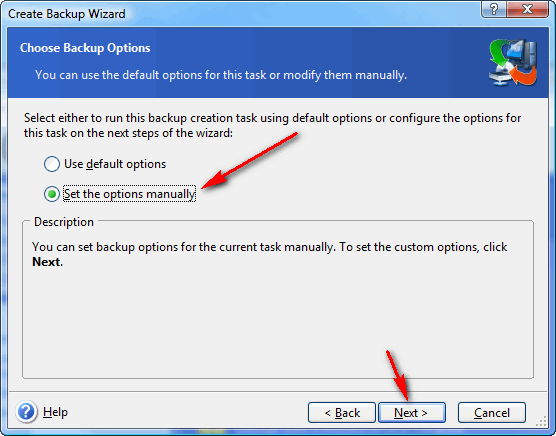
For most of us, there are only 3 options worth looking at: compression, priority and splitting:
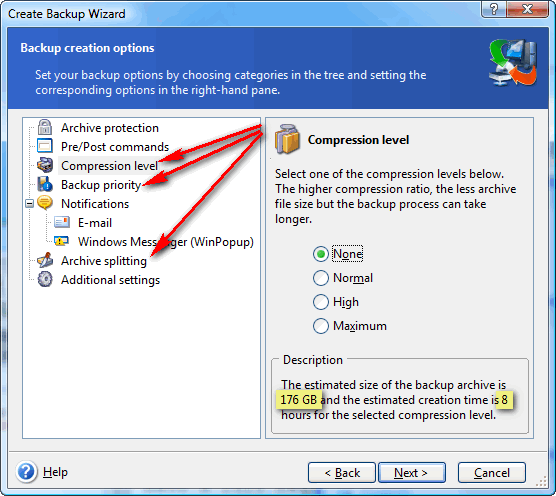
Click on the different compression options consider the trade-offs in size and time:
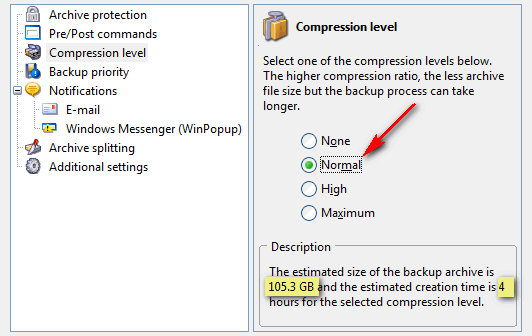
Choosing "Normal" over "None" is a no-brainer, it says the backup will finish sooner and require less space.
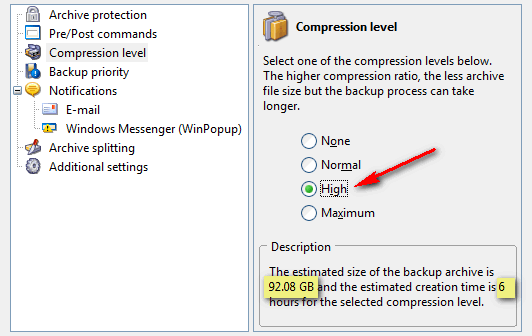
If you're going to let it run overnight, you might as well choose High or Maximum. Remember, these are estimates ... because I was in a hurry I did a Normal backup and as I remember it finished in less that 2 and a half hours instead of the 4 estimated.
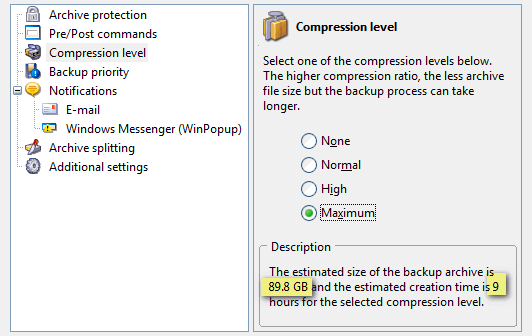
When it comes to priority, for anything other than a full backup, "Low" is probably a good choice. If you're don't a full backup I advise against doing anything else at the same time and would choose "Normal" or "High":
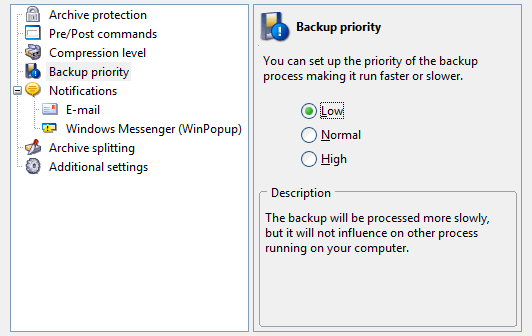
If you're always going to keep your backup on external hard drives, "Automatic" is an OK choice for splitting.
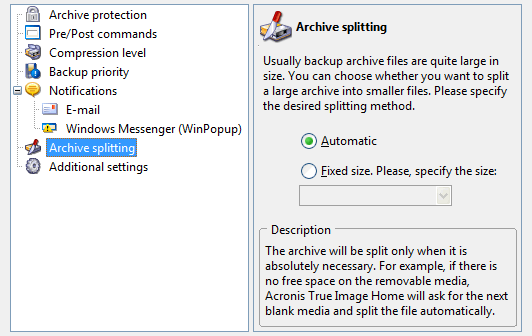
However, I like the option of being able to later copy to DVDs, so prefer to split. The problem is you ONLY have these choices:
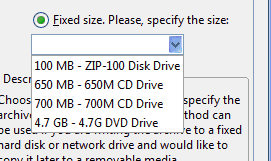
If you choose 4.7G option for DVD it creates multiple 4.3GB files on your hard drive which in theory would fit on a DVD, but obviously Acronis has never tried. The specs for the standard DVD file system limits the size of any individual file to 4GB, so this option is useless. They should let you specify whatever size you want or give you options that are actually useful.
Once you've selected your options and clicked "Next", you have the chance to write a short description of the state of the machine (e.g., before installing ...) and/or why and when you made the backup.

After you click next, it summarized what it is about to do:
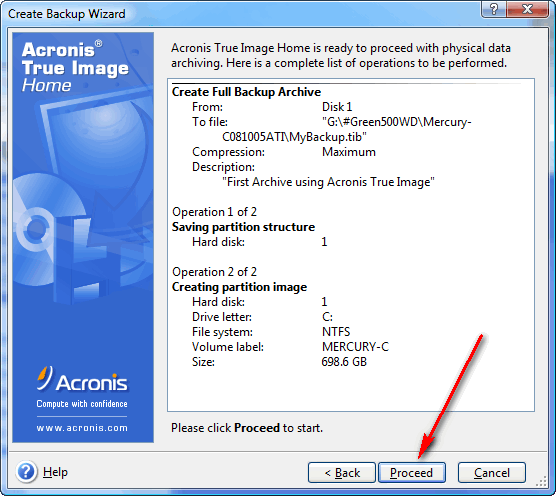
One nice feature is that if you see something you don't like (like maybe this time you want to do a faster backup and not use Maximum compression) you can click "Back" a few times, make the change and the click "Next" a few times to get back to this screen. Once you're ready to start the backup click "Proceed".
After you've made your backup (or even before) you need to create a bootable CD that will allow you to restore it should you have to replace your hard drive:
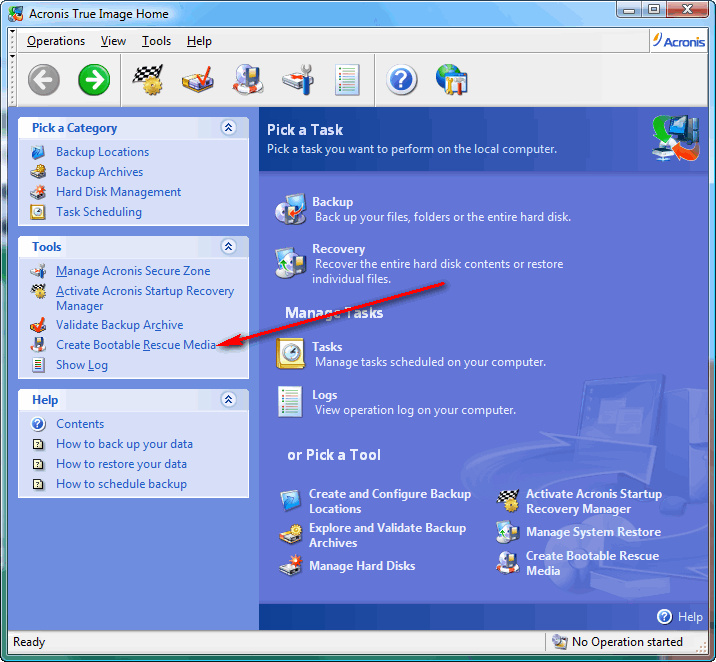
It starts another wizard. Here I recommend you check BOTH the safe version and the full version:

Next it will ask you to choose the media. I have to CD/DVD drives, so I selected the first and clicked "Next":
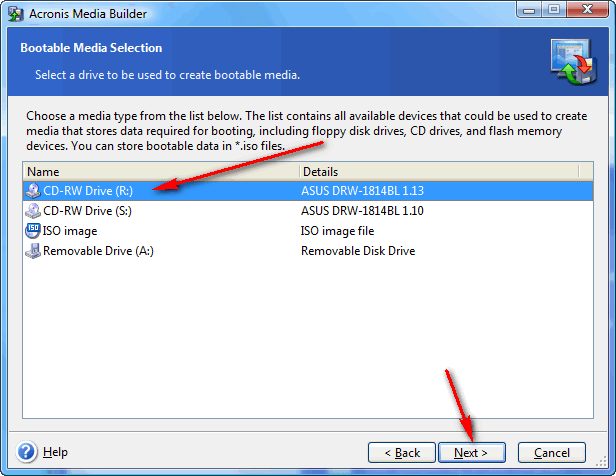
Again it summarizes what it's about to do and you have to click "Proceed" to start the process:
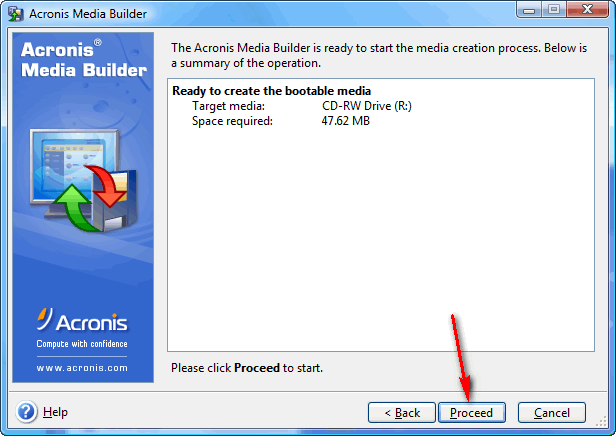
This is also important. You want to go through the recovery process, up to the point of actually starting the recovery. It's important to do this before you're in a crisis and under stress. Once you've done it you'll feel confident that you can recover you data should it ever be necessary.
Insert your Bootable Recovery Media and restart your system. If Windows re-starts, you need to change your BIOS setup to boot from your CD first (unlike the old diskettes which you had to remove when you BIOS was set to boot from them, it will only boot from a CD if it is bootable ... very few are). Assuming it boots from your Recovery CD you'll see:
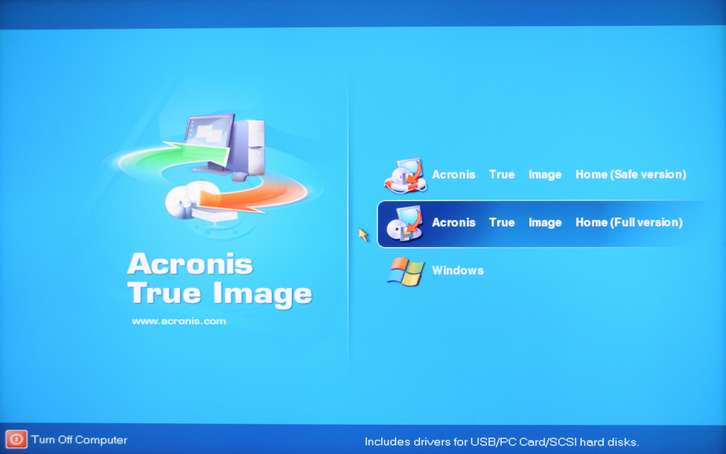
As you'll remember, when we created the bootable CD we put two versions of True Image on it, the Safe version and the Full version. As you can see by the description (bottom above) because our backup is on an external hard drive connected via USB, we need the full version which has the USB and other drivers. After choosing that we see:
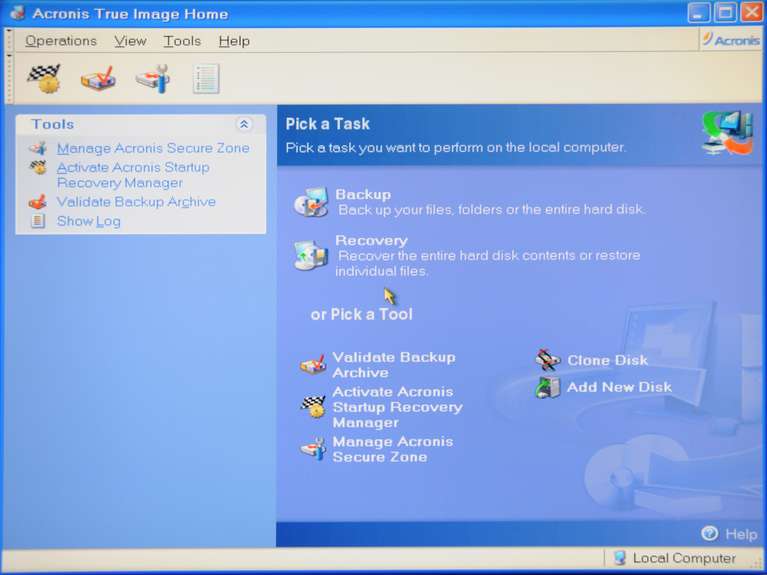
Obviously here the choice is "Recovery", which starts this wizard:
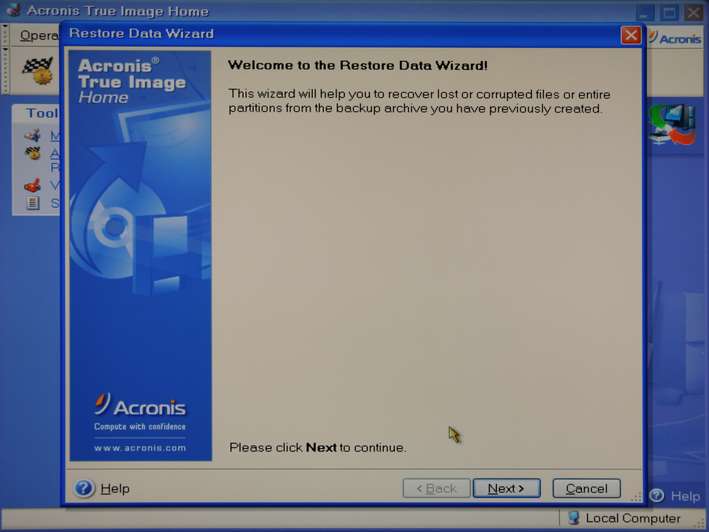
But as soon as we click "Next" we get:

If we had just lost out hard drive, we would TOTALLY freak out. This is why I rate this product unacceptable.
I have no idea what the problem is, I tried many things with no success:
My personal guess, is that it might be trying to verify that you have a valid license. However, the copy I installed is certainly valid ... maybe the problem is that I didn't install it in the "Program Files" folder like most people do ... but they gave me the option to install it somewhere else ... when given the choice I haven't ever installed anything in that folder. It that's the problem, I could accept that it wouldn't let me backup.
However, what I'm trying to do is RESTORE. That's why I tried #4 above, if you've just replaced your hard drive Acronis isn't going to be installed anywhere one it ... all you've got is your bootable media and your backup. If this happened after to you after you lost your hard drive you would flip out.
Bottom Line: An unacceptable product. Although differential backup seems like a nice feature, it's pretty useless if you can't run restore. I've asked Acronis to respond ... I'll let you know if I think they have a valid excuse for why the product failed ... who knows, it could well be operator error ![]() ,
,
Suggested next choices:
ImagingTips.com Site Map
[an error occurred while processing this directive]